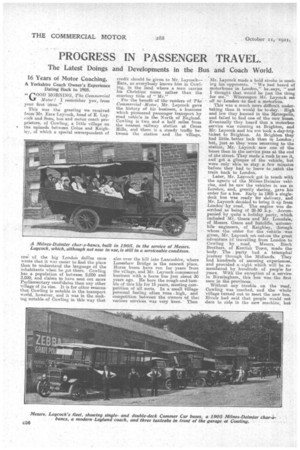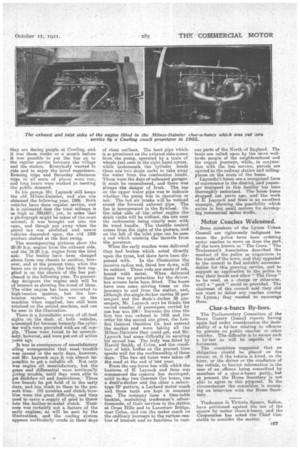PROGRESS IN PASSENGER TRAVEL.
Page 46

Page 47

If you've noticed an error in this article please click here to report it so we can fix it.
The Latest Doings and Developments in the Bus and Coach World.
16 Years of Motor Coaching,
A Yorkshire Coach Owner's Experience Dating Back to 1905.
OOD MORNING, The Commercial • Jr Motor! I remember jou-, from your first issue."
This was the greeting we. received from Mr. Ezra Layeeck, head of E. Laycock and Sons, bus and motor coach•proprietors, of Cowling; a little village on the uplands between Coins and Keighley, of which a special correspondent of
one of the big London dailies once wrote that it was easier to. find the place than to understand the language of the inhabitants when he got there. Cowling has a population of between 2,000 and 3,000, and claims to have sent, out more Parliamentary candidates than any other village of its size. It is for other seasons that Cowling is notable in the transport world, however, and it was in the making notable of Cowling in this way that
credit should be given. to Mr. LaycockEzra, as everybody knows him hi Cowling, in the land where a man carries hie Christian name rather than the • courtesy title of "Mr." •
' For the benefit of -the readers of The Commercial Motor, Mr. Laycock gave the history of his business, a business which pioneered passenger transport by road vehicle in the North of England. Cowling is two and a half miles from the nearest railway station at Cross Hills, and there is a. steady traffic between the station and the village,
also over the hill into Lancashire, where Laneshaw Bridge is the nearest place. Horse buses have run for years from the village, and Mr. Laycock commenced business with a horse bus just about 30 years ago. He bore the rough-and-tumble of this life for 15 years, meeting competition of all sorts. In a small village personal feeling often runs high, and competition between the owners of thel various services was very keen. Then
Mr. Layecick made a bold stroke in meeting his opponents. "We had heard of motorbuses in London," he.says, "and I thought that would be just the thing for me." Whereupon Mr. Laycock vet off toLondon to find a .motorbus.
This was a much more difficult undertaking than it would be to-day. High and low they hunted in the Metropolis, and failed to find one of the new buses. Eventually they heard that a motorbus service was running at Brighton, and Mr: 'Aycock and his son took a. clay-trip ticket to Brighton. At Brighton they had little, better luck than in London; but, just as they were returning to the station, Mr. Laycock saw one of the buses then in the service pass at the end of the street,. They made a rush to see it, and got a glimpse of the vehicle, but were only able to stay a few minutes before they had to leave to ,catch the train back to London.
Later, Mr. Laycock got in touch with the agents of the Milnes-Daimler vehicles, and he saw the vehicles in use in London, and, greatly daring, gave his order for a, bus. Early in 1905 a single. deck bus was ready for delivery, and Mr. Laycock decided to bring it up from London by road. The engine was described as being of 28-30 h.p. Accompanied by quite a holiday party, which included Mr. Grace and Mr. Lonsdale, of Messrs. Grace and Sutcliffe, automobile engineers, of Keighley, hrough whom the order for the vehicle was given, Mr, Laycock set out.on the great adventure of travelling from London to Cowling by road. Messrs. Birch Brothers, of Kentish Town, made the body. The party had a triumphal journey through the Midlands. They had hundreds of amusing experiences, and provided. a-sight which will be remembered by hundreds of people, for years. With the exception of a service in Birmingham, this bus was the first seen in the provinces.
Without any trouble on the Toad, Cowling was reached, and the whole village turned out to meet the new bus. Rivals had said that people would not dare to side in the new machine, but they are daring people at Cowling, and it was three weeks or a month before it was possible to put the bus on to the regular service between the village and the station. Everybody wanted to ride and to enjoy the novel experience. Evening trips and Saturday afternoon trips to all sorts of places were run, add long hours were worked in meeting the public demand.
In his garage Mr. Laycock still keeps the old Milnes-Daimler, and ' also one obtained the following year, 1906. Both vehicles have done regular service, and it is estimated that the total mileage is as high as 300;000; yet, in order that a photograph mightbe taken of the mose ancient, it was brought out into the open, and though put away when the petrol tax was abolished and newer vehicles depended upon, the old 1905 product started at the first swing.
The accompanying pictures show the 28-30 h.p. engine from the exhaust side, and the 18-20 h,p. engine from the inlet side. The bodies have beets changed about from one chassis to another, however, and at the present time, when the buses are in storage, the body first supplied is on the chassis of the, bus purchased in the following year. To presentclay designers the engine unit will be of interest as showing the trend of ideas. The older engine has been converted to high-tension ignition, but. the lowtension system, 'which was on the machine when supplied, has still been retained on the second machine, and can be seen in the illustration.
There is a formidable array of oil-feed sights on. the dash of both vehicles, accounted for because formerly the cylins der walls were provided with.an oil supply.. These were found to be unnecessary, however, and were put out of action years ago.
It was in consequence of unsatisfactory ailing arrangements that most trouble was caused in the early days, however, and Mr. Laycock says it was almost ire.passible to get a suitable oil. Not only was engine oil unsatisfactory, but the gears and differential were continually giving trouble, until they were able to get Jackdaw -oil and Ambroleum. These two brands he got hold of in the early days, and has stuck to them to the present time. Oil troubles and clutch troubles -were the great difficulty, and they used to carry a supply of sand to throw into the leather-to-metal clutch. Neatness was certainly not a feature of the early engines, as will be seen by the illustrations, and the cooling system appears particularlycrude in these days of dean outlines, The bent pipe which is so prominent on the exhaust side comes from the pump, operated by a train of wheels just seen in theright-hand corner, while underneath the 'cylinder heads there are two drain cocks to take away the water from the combustion heads. Those were the days of unheated garages, it must be remembered, and there was always the danger of frost. The tap on the upper water pipe was to indicate whether the pump was in operatioe, or not. The hot air Intake will be noticed round the forward exhaust pipe. The fan is incorporated in the flywheel. On the -inlet side of the: other engine the chair} cocks will be noticed, the one near the carburetter being bleerly seen with its wood handle. The throttle control comes from. the right of the picture, andon the left of the inlet pipe can be seen a rod which controls the throttle from the governor.
When the early coaches were delivered they had 'brakes which acted directly upon the tyres, but these have been dis
pensed with. In the illustration the massive radius rod, fitted low down, will be noticed. These rods are made of ash, bound with metal. When delivered there was no protection for the driver, but screens have been fitted. The buses have seen some stirring times on the journeys to and from the station, and, although the-single-decker carries 18 passengers and the deub'e-decker 38 passengers-, Mr. Laycock says he thinks the record number of passengers carried by one bus was 104 !• Between the tune the first bus was ordered in 1.905 and the order for the second One given the London Ceeneral Omnibus Co. had entered the market and were taking all the Milnes-Daimlers they could get, and Mr. Laycock had some difficulty in securing his second bus. The body was fitted by Harold Smith, of Colne, and the condition of bath bodies at the present time speaks well for the workmanship of those days. The two old buses were taken off the road at the end of lest year. From the ono-horse hue with which the business of li Laycock and Sons was commenced the concern has developed, until to-day two Commer Oar buses, one a, double-decker and the other a saloontype 3P pattern, a Leyland motor coach and three taxis are kept in constant use. The company issue a time-table booklet, containing tradesmen's advertisements, of their services to the station at Cram Hills and to Laneshaw Bridge, near Colne, and run the motor coach on the ordinary journeys to the various centres of interest and to functions in vari
ous parts of the North of England. The taxis are called upon by the more 'wellto-do people of the neighbourhood and for urgent journeys, while, in conjunction with the bus service, parcels are carried to the railway station and callingplaces on the route of the buses.
Laycoeles's buses are a recognized form of conveyance in the' district.? and passenger transport in this locality has been thoroughly motorized. The horse buses dropped out years ago and the work of E. Laycock -and Solt; is an exoellent example, showing the possibility which exists in but small centres for developing cenamercial motor traffic.
Motor Coaches Welcomed.
Some -members of the Lymin Urban Council are righteously indignant because the police have been -ordering motor coaches to move on from the part. of the town known as "The Cross." The Tradesmen's Association described the conduct of the police as ungracious to the trade of the town, and they appealed to the council to find suitable accommodation for this growing service, and to support, an application to the police to stay their hands and allow " The Cross" to be used, at a charge or otherwise, until a " park " meld be provided. The chairman of the council said they did not want to debar any coaches coming to Lymm; they wanted to encourage them.
Char-a-banes By-laws.
The Parliamentary Committee of the Essex County Council reports having again had under consideration the desirability of a by-law relating to offences by persons on public coaches or other vehicles. The difficulty is to secure such a by-law as will be capable of enforcement.
The committee suggested that an Obligation should be placed on the owner, or, if the vehicle is hired, on the hirer, or the -driver or the conductor of the vehicle, to furnish information in the case of an offence being committed by
members of a char-e-bencs i party,. but at present the Home Secretary s not able to agree to this proposal. In the circumstances the committee is arranging an interview with the Home Secretary.
Tradesmen in Victoria Square, Bolton, have petitioned against the use of the square by motor char-i-bancs, and the Corporation has asked the Chief Constable to consider the matter.




















































